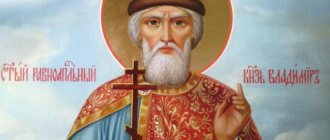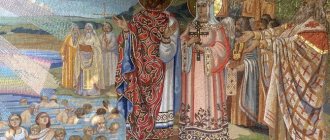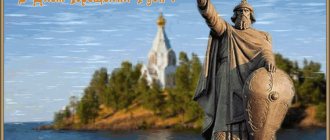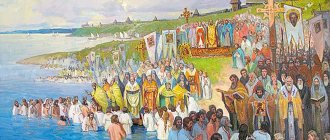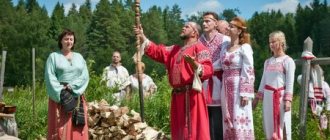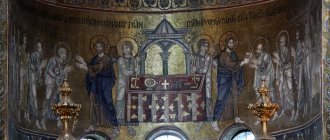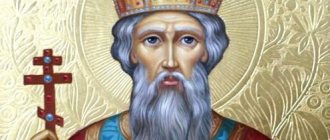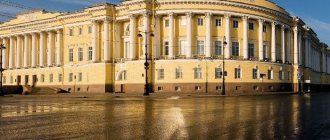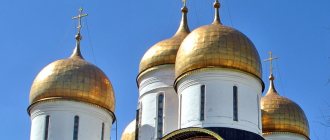The 1000th anniversary of the baptism of Rus' is a major religious holiday that took place in the USSR in 1988. Organizer – Russian Orthodox Church.
Vladimir Svyatoslavich - Prince of Novgorod (970-988), Prince of Kiev (978-1015), under whom the baptism of Rus' took place, 988. Moscow, Borovitskaya square
An atheist state proposes to hold a church holiday
Prince Vladimir baptized Rus' in 988. The 1000th anniversary occurred during an atheistic period in the life of the country. But the state participated in preparations for the holiday.
Here is what the head of the Department of History of the Russian Orthodox Church of the BF PSTGU, Archpriest Alexander Shchelkachev, says about this:
“The anniversary of the Millennium of the Baptism of Rus' is an important event for the Russian Church, but at that time there were persecutions in Russia, and the Church could not take the initiative to hold church celebrations at the state level, so the proposal to hold the holiday came from the Communist Party.
In the Church it seemed that there would be no celebrations. One can only guess why the Communist Party decided to hold the celebrations. Perhaps in order to demonstrate to the whole world that we do not have persecution of the Church, perhaps out of fear that if the holiday is not celebrated here, the initiative will be seized by the Church Abroad. But at the same time, God’s providence was felt. The closer the time of the holiday approached, the clearer this became.
I heard a short story that characterizes the church-political situation of that time. During preparations for the holiday, all the abbots of Moscow churches were called. Father Vladimir Rozhkov, rector of the Nikolo-Kuznetsk Church before Father Vladimir Vorobyov, was summoned to the Commissioner for Religious Affairs. Moreover, when going to him, he hid the cross and cassock.
Suddenly the commissioner began to say that our task is to properly celebrate the Millennium of the Baptism of Rus': “What needs to be done for this”? Father Vladimir understood what the conversation would be about and what the situation was, put on a cassock, a cross and said that it was necessary, first of all, to eliminate the puddle that was in front of the entrance to the Nikolo-Kuznetsky Church.”
Source pravmir.ru
Meeting with M. S. Gorbachev and Patriarch Pimen in the Catherine Hall of the Kremlin to prepare for the 1000th anniversary of the introduction of Christianity in Rus'. April 29, 1988
History of the Baptism of Rus'
Kiev Prince Vladimir Svyatoslavich was baptized in 988. According to the oldest Russian chronicle - “The Tale of Bygone Years”, the ceremony took place in the Byzantine settlement in Crimea - Korsun (Greek name - Kherson, now the territory of the city of Sevastopol). According to other sources, Vladimir was baptized in Kyiv or in one of his residences near it.
After the adoption of Christianity, Vladimir ordered the destruction of pagan temples in Russian cities, organized the baptism of the people of Kiev, and later the rest of the inhabitants of the Old Russian state. In 996, a Russian metropolitanate was established in Kyiv, subordinate to the Patriarchate of Constantinople, and episcopal sees were established in other centers of Rus' (in particular, in Novgorod). In the 990s, construction of the first stone and wooden churches began. In general, the process of Christianization of Ancient Rus' was completed by the 12th-13th centuries. Baptism contributed to the flourishing of culture, the spread of literacy and books, the development of architecture and other forms of art.
According to historians, Vladimir’s adoption of Christianity was due to both his personal spiritual quest and a number of domestic and foreign policy reasons. Paganism did not suit the prince as a state ideology, since it contradicted the idea of centralizing state power. In addition, the adoption of Christianity made it possible to introduce Rus' into the ranks of the leading European powers of its time and significantly increase its international status. Historians also note that Vladimir could have been prompted to accept Christianity by the memory of his father’s mother, Princess Olga, who was baptized in Byzantium in the 950s.
June 5–12, 1988 celebrated the anniversary of baptism
The main anniversary celebrations took place in Zagorsk and Moscow on June 5–12. At the same time, the Local Council was appointed - this is a large religious meeting at which bishops, presbyters, deacons and laity discuss issues of faith, reforms of church life, and confirm new saints.
Participants of the Local Council, as well as 517 guests, including heads of local Orthodox churches, came to Moscow:
- Patriarch of Antioch Ignatius IV.
- Patriarch of Jerusalem Diodorus.
- Catholicos-Patriarch of All Georgia Ilia II.
- Patriarch of Bulgaria Maxim.
- Archbishop Chrysostomos I of Cyprus.
- Metropolitan of Warsaw Vasily.
- Metropolitan Dorotheos of Prague.
- Metropolitan of All America and Canada Theodosius.
On June 13, 1988 in Moscow, Patriarch Pimen laid the foundation stone of the temple dedicated to the 1000th anniversary of the Baptism of Rus'. The temple is located in the Tsaritsyn Ponds area, near the Kashirskoye Highway.
The holidays began in the Moscow Epiphany Cathedral with the Divine Liturgy.
Patriarch Pimen in the Epiphany Cathedral opens the celebrations dedicated to the celebration of the 1000th anniversary of the baptism of Rus'
Throughout the week from June 5 to June 12, there were festive services in Moscow churches, and on June 11 an all-night vigil was held. This is a special solemn service that takes place in the evening.
The All-Night Vigil consists of:
- Vespers
is the first service that recalls and depicts Old Testament times. They remember how God created the world, how the first people sinned, how they were expelled from paradise, they repented and prayed for salvation. The service also mentions hope according to God's promise and how the promise was fulfilled. - Matins
is the second service, which recalls New Testament times: how Jesus Christ came into the world, lived, died and was resurrected. - The first hour
is a short prayer reading for 15–20 minutes, where believers ask God to hear their voice and correct the works of their hands during the day.
In ancient times, the all-night vigil began late in the evening and continued all night until dawn. During such a service, the temple is illuminated more than on other days.
Celebration in Moscow
Commemorative medal in honor of the celebration of the 1000th anniversary of the baptism of Rus'. These were sold in the shop of the Trinity-Sergius Lavra in 1988
The Divine Liturgy was held on the square of the Danilov Monastery, which had just been restored from its dilapidated state. It was done:
- Patriarch of Antioch Ignatius IV.
- Patriarch of Jerusalem Diodorus I.
- Patriarch of Moscow Pimen.
- Catholicos-Patriarch of All Georgia Ilia II.
- Patriarch of Romania Theoktist.
- Patriarch of Bulgaria Maxim.
- Archbishop Chrysostomos I of Cyprus.
Rite of Divine Liturgy in Danilov Monastery
Local Council June 6–9, 1988
Local cathedral.
This was the fourth Local Council for the Russian Orthodox Church. On June 6, the Local Cathedral opened in the Trinity-Sergius Lavra. It ran until June 9.
Council decisions:
- A new Charter was adopted, according to which the clergy controlled the economic affairs of the parishes. Before this, the church was subject to the parish government reform of 1961 - as a result, church money was often distributed by non-believing people from outside.
- Nine new saints were canonized: Prince Dimitri Donskoy, St. Andrei Rublev, St. Maxim the Greek, St. Macarius of Moscow, St. Paisius of Velichkovsky, Blessed Xenia of Petersburg, St. Ignatius Brianchaninov, St. Ambrose of Optina, St. Theophan the Recluse.
Causes
The turn of power towards the church was explained by the failures of perestroika. The economic effect of the “acceleration” policy and the creation of cooperatives turned out to be insignificant. At the same time, public discussion of sensitive topics, primarily related to the history of the early Soviet period, revealed contradictions that needed to be smoothed out by abandoning the most odious “excesses” of domestic policy. Finally, for the success of international diplomacy, Gorbachev needed a clear symbol of change, meaning that the USSR was no longer the “evil empire” as Ronald Reagan once claimed.
The activation of church life in the Soviet Union coincided with the socio-economic crisis of the 1980s and 90s. Faith in God has helped many people who were faced with the collapse of their former ideals to survive difficult times.
In honor of the holiday, a bell tower, a chapel and a temple were built in Moscow
The Moscow Patriarchal Metochion in honor of the 1000th anniversary of the Baptism of Russia.
The buildings were erected on the banks of the Borisov Ponds. The buildings are visible from Kashirskoye Highway, from which a white-stone arched pedestrian bridge leads to the gate bell tower.
11 bells (the largest weighing almost 2500 kg) were brought to the courtyard in 2001.
In 2002, they were installed on the bell tower, and in 2003, a platform was built and a ringing “control system” was installed.
Moscow Church of the Life-Giving Trinity in Orekhov-Borisov
Moscow Church of the Life-Giving Trinity in Orekhov-Borisov
The capacity of the massive temple is up to three thousand people, the height with the cross is 70 meters. This is a single-domed cubic building, to which semi-circular exedra are attached on all four sides, which made the plan of the temple cruciform.
In the eastern exedra there is the main altar, in the side chapels there are chapels, and the western one is the vestibule. The temple is covered with a powerful sail vault resting on the walls, as in ancient Byzantine buildings. The building is completed by a hemispherical ribbed dome. His drum has twelve windows according to the number of apostles. The semi-domes of the exedra repeat the shape of the dome and are almost equal in diameter, which is why the temple seems multi-domed.
Alexander Nevsky Chapel
Alexander Nevsky Chapel
The chapel in the name of the blessed Grand Duke Alexander Nevsky is the first structure that was erected on the patriarchal courtyard. Located southwest of the temple. The building is crowned with a hemispherical head on a high faceted drum.
Chapel height - 16.4 m
Bell tower of the Moscow Patriarchal Metochion
Bell tower of the Moscow Patriarchal Metochion
The building is located on the western side of the metochion, at the edge of the pedestrian bridge leading from Kashirskoye Highway. The bell tower is completed with a dome and semi-domes similar to the temple ones, but smaller in size.
